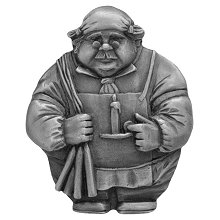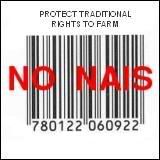The Candlestick Maker

The Candlestick Maker
Jack be nimble
Jack be quick
Jack jump over
The candlestick.
Now considered in a more decorative or atmosphere enhancing role, the humble candle over several millennia provided the main source of light for dwellings and public buildings.
Beeswax candles were used in Egypt and Crete as far back as 5,000 years ago. In Medieval Europe cheap everyday candles were made from tallow (melted-down fat). Remains of highly crafted candelabra were excavated in abundance from the scorched ruins of Pompeii. The earliest surviving specimen of a candle was found near Avignon in France and dates from the first century A.D.
The oldest candle manufacturers still in existence are Rathbornes Candles, founded in Dublin in 1488. For more than 500 years Rathborne Candles have been casting their soft glowing light on some of the most momentous events of Irish history.
Beeswax candles were used in Egypt and Crete as far back as 5,000 years ago. In Medieval Europe cheap everyday candles were made from tallow (melted-down fat). Remains of highly crafted candelabra were excavated in abundance from the scorched ruins of Pompeii. The earliest surviving specimen of a candle was found near Avignon in France and dates from the first century A.D.
The oldest candle manufacturers still in existence are Rathbornes Candles, founded in Dublin in 1488. For more than 500 years Rathborne Candles have been casting their soft glowing light on some of the most momentous events of Irish history.
The trade of the chandler is also recorded by the more picturesque name of "smeremongere",
since they oversaw the manufacture of sauces, vinegar, soap and cheese.
since they oversaw the manufacture of sauces, vinegar, soap and cheese.
Founded in Dublin in 1488, the time of knights and battles, walled towns, cloistered monasteries and when the great Garret Mor Fitzgerald (The Great Earl) was the Lord Deputy of Ireland, Rathborne Candles lit the way through the dark Middle Ages of Irish and European history.
The annals of ancient Ireland record candles as thick as a man's body and the length of -a hero's spear. It was the custom at night to burn a massive torch outside the tents of campaigning kings. Those crude but effective instruments of light - were usually made by repeatedly dipping wicks of peeled rushes into melted tallow. Beeswax was reserved for the houses of the rich and the Catholic Church still prescribes this ingredient for liturgical use.
During the middle ages of Europe, the popularity of candles is shown by their use in Candlemas and on Saint Lucy festivities. Tallow, fat from cows or sheep, became the standard material used in candles in Europe. The Tallow Chandlers Company of London was formed in about 1300 in London, and in 1456 was granted a coat of arms. By 1415 tallow candles were used in street lighting.
The trade of the chandler is also recorded by the more picturesque name of "smeremongere", since they oversaw the manufacture of sauces, vinegar, soap and cheese. The unpleasant smell of tallow candles is due to the glycerin they contain. For churches and royal events, candles from beeswax were used, as the smell was usually less unpleasant.
Originally an industry carried on in monasteries or at home, candle making became an established craft by the Middle Ages and the first recorded guilds were formed in Paris in the thirteenth century. The first candle mould comes from 15th century Paris. The smell of the manufacturing process was so unpleasant that it was banned by ordnance in several cities.
From the l4OOs candle lanterns were usually used for street lighting until largely replaced by oil and gas burners in the eighteenth and nineteenth centuries respectively.
Timekeeping candles have been recorded from the ninth century. These had twelve divisions marked on them and they burned for twenty-four hours. Candles based on this system were used in coalmines until about forty years ago to measure the duration of a work shift.
In the late 18th century a better material was discovered for candles. Known as spermaceti it was a substance found in the head of the sperm whale. Stearine, discovered in 1823, produced an even more stable, less smokey and brighter light.
But the greatest advance came in 1857 when paraffin wax, still the mainstay of production-today. In 1829, William Wilson of Price's Candles invested in 1,000 acres (4 km2) of coconut plantation in Sri Lanka. His aim was to make candles from coconut oil. Later he tried palm oil from palm trees. An accidental discovery swept all his ambitions aside when his brother George Wilson distilled the first petroleum oil in 1854. By 1922, the Lever Brothers had purchased Prices Candles and in 1922 a joint-owned company called "Candles Ltd" was created. The three owners are known as Shell Oil Company, BP and Burmah Oil. By 1991, the last remaining owner of "Candles Ltd" was Shell, who sold off the candle-making part of business.
Despite advances in candle making, the candle industry was devastated soon after by the distillation of kerosene (an excellent fuel for lamps). (In Britain kerosene is known as paraffin oil or paraffin despite having little to do with paraffin wax). From this point, candles became more of a decorative item.
…………..and that as they say folks, is History.
The annals of ancient Ireland record candles as thick as a man's body and the length of -a hero's spear. It was the custom at night to burn a massive torch outside the tents of campaigning kings. Those crude but effective instruments of light - were usually made by repeatedly dipping wicks of peeled rushes into melted tallow. Beeswax was reserved for the houses of the rich and the Catholic Church still prescribes this ingredient for liturgical use.
During the middle ages of Europe, the popularity of candles is shown by their use in Candlemas and on Saint Lucy festivities. Tallow, fat from cows or sheep, became the standard material used in candles in Europe. The Tallow Chandlers Company of London was formed in about 1300 in London, and in 1456 was granted a coat of arms. By 1415 tallow candles were used in street lighting.
The trade of the chandler is also recorded by the more picturesque name of "smeremongere", since they oversaw the manufacture of sauces, vinegar, soap and cheese. The unpleasant smell of tallow candles is due to the glycerin they contain. For churches and royal events, candles from beeswax were used, as the smell was usually less unpleasant.
Originally an industry carried on in monasteries or at home, candle making became an established craft by the Middle Ages and the first recorded guilds were formed in Paris in the thirteenth century. The first candle mould comes from 15th century Paris. The smell of the manufacturing process was so unpleasant that it was banned by ordnance in several cities.
From the l4OOs candle lanterns were usually used for street lighting until largely replaced by oil and gas burners in the eighteenth and nineteenth centuries respectively.
Timekeeping candles have been recorded from the ninth century. These had twelve divisions marked on them and they burned for twenty-four hours. Candles based on this system were used in coalmines until about forty years ago to measure the duration of a work shift.
In the late 18th century a better material was discovered for candles. Known as spermaceti it was a substance found in the head of the sperm whale. Stearine, discovered in 1823, produced an even more stable, less smokey and brighter light.
But the greatest advance came in 1857 when paraffin wax, still the mainstay of production-today. In 1829, William Wilson of Price's Candles invested in 1,000 acres (4 km2) of coconut plantation in Sri Lanka. His aim was to make candles from coconut oil. Later he tried palm oil from palm trees. An accidental discovery swept all his ambitions aside when his brother George Wilson distilled the first petroleum oil in 1854. By 1922, the Lever Brothers had purchased Prices Candles and in 1922 a joint-owned company called "Candles Ltd" was created. The three owners are known as Shell Oil Company, BP and Burmah Oil. By 1991, the last remaining owner of "Candles Ltd" was Shell, who sold off the candle-making part of business.
Despite advances in candle making, the candle industry was devastated soon after by the distillation of kerosene (an excellent fuel for lamps). (In Britain kerosene is known as paraffin oil or paraffin despite having little to do with paraffin wax). From this point, candles became more of a decorative item.
…………..and that as they say folks, is History.


3 Comments:
Hi Scott,
It's nice to have you back blogging. Thanks for the history lesson. Very interesting. And I REALLY like your coffee company logo!
This was fascinating, Scott. I'm glad you're back on board continuing this series. I love the look of candlelight, but I've stopped buying paraffin wax candles because of the sooty residue they leave on my walls and ceilings, not to mention other surfaces. Soy wax seems to be a new choice these days. I've tried it and notice it is not too smokey. If it were not for electricity I imagine there would be more discussion of alternate sources of light and candle-making on the agrarian blogs! I wonder if everyone who is raising bees will be using the wax.
I am attempting to write an educational piece on molded candles in the 15th century. Is it possible to get your documentation on your statement that the first candle molds were in Paris in the 15th century? I have been desperately searching for solid evidence of this. Thank you for your time in advance.
Post a Comment
<< Home